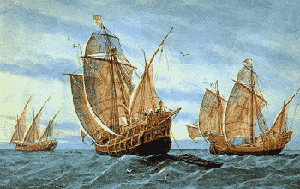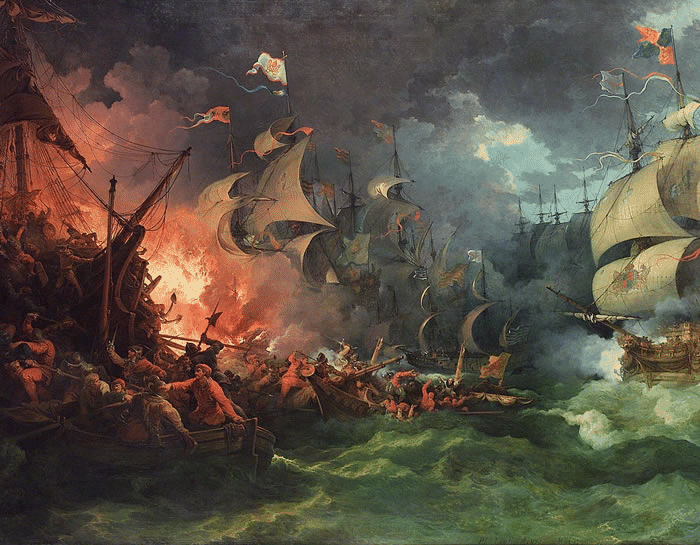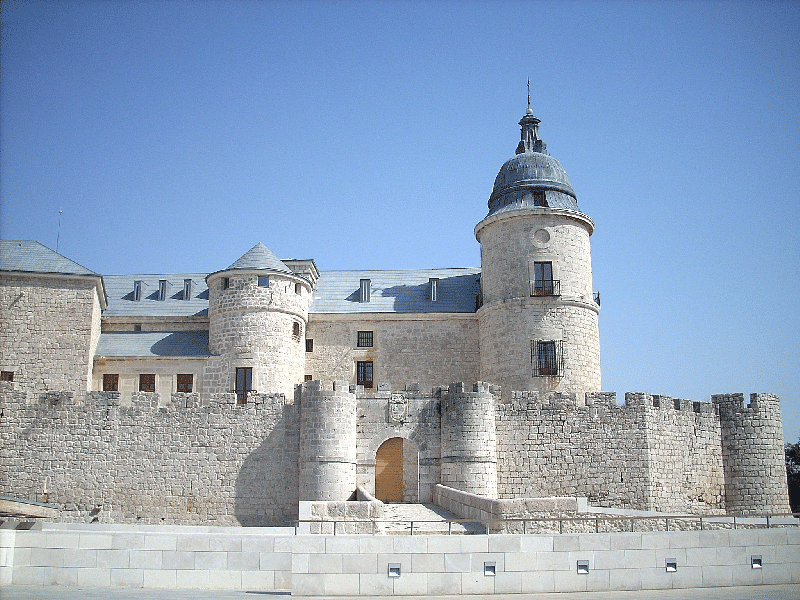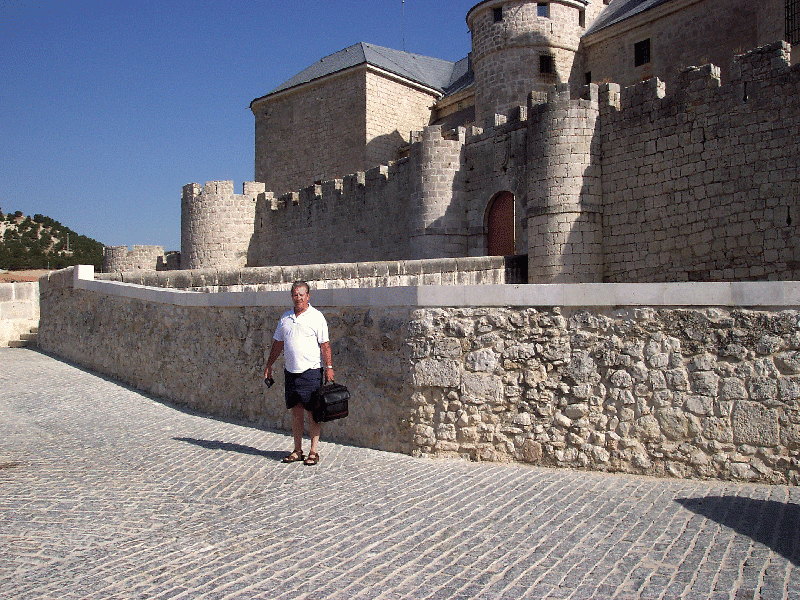Lomas
A British Family
Spanish Connection

The Defeat of the Spanish Armada
Armada is the Spanish word for a "fleet" (of ships). In 1588, the defeat of the mighty Spanish Armada in the English Channel by the English proved to be an event of significant military, political and religious importance in sixteenth century Europe. The failure of the Armada expedition to assist in a proposed large-scale invasion of England, finally extinguished the hopes and aspirations of a large group in England who deeply wished for the re-establishment of a Catholic monarch on the English throne and a return to close links with the Church of Rome.
The concept of the Spanish Armada was first proposed by Admiral Don Alvaro de Bazan Marquis of Santa Cruz (1526-1588), just before the outbreak of the Anglo-Spanish War (1587-1604). King Philip II (1527-1598), angry at England's growing involvement in the Netherlands campaign, where they had dispatched troops to assist Protestant Dutch against the Spanish army of Alessandro Farnese, Duke of Parma (1545-1592), decided to attempt to overthrow the English Queen, Elizabeth I (1533-1603) and establish himself as sovereign in her place. With his approval, plans commenced in 1586 under the direction of Santa Cruz, to raise a large combined land and naval force designed to attack and conquer England.
The English government meanwhile was fully informed of the developing situation and undertook extreme measures to disrupt the Spanish preparations. Sir Francis Drake (c. 1540-1596) had recently returned home in July 1586 from a voyage in the Caribbean, where he had raided and plundered Spanish settlements at Cartagena; St. Augustine; San Domingo and Santiago. Drake was dispatched back into Spanish waters in command of a fleet of 23 warships with orders to damage and disrupt the enemy war effort. The English fleet assaulted Cadiz on the 19 April 1587 and destroyed 33 Spanish vessels. Drake also struck at Lisbon and sacked the city, which was then under Spanish control. Despite this show of English aggression, Drake's actions failed to prevent the Spanish plans continuing through the year of 1587 and into 1588.
The sudden death of Santa Cruz on the 30 January 1588 did present a minor problem to the venture and resulted in the appointment of the less experienced Don Alonso Perez de Guzman, Duke of Medina Sidonia (1550-1619) as commander in Chief of the Armada, with AdmiraL Juan Martinez de Recalde chosen as his deputy. Medina Sidonia's mission was to sail the Armada to the Netherlands, where Parma was then to assume overall control of the invasion expedition as soon as the Spanish fleet arrived.
Meanwhile, the English were ready to resist the Spanish invasion. A large army had already been raised on land to meet the threat, and arrangements were finalised to also engage the enemy at sea. Ships were armed and made ready for war and stood in various south coast ports ready to sail as soon as danger appeared. The two main squadrons were situated at Plymouth and in the Downs. The Commander in Chief of the English fleet was the Lord High Admiral, Charles, Baron Howard of Effingham (1536-1624) and Drake was selected to act as his Vice Admiral. Effingham and Drake's squadron consisting of about 94 ships, lay at Plymouth, in Devon, their task being to engage the enemy fleet once it entered the Channel.
At the Downs station near Dover, in Kent, was positioned the second squadron of around 35 ships under Lord Henry Seymour (fl.1588), whose assignment was to keep a watch on Calais and deal with any attempt by Parma to cross over to England from the continent with his forces. The total manpower employed in the English fleet was around 16,000. With their army and navy now assembled the English awaited developments.
The Armada under Medina Sidonia sailed from Lisbon, on the 30 May 1588 with a formidable force of 138 ships, carrying over 25,000 seamen and soldiers, but moving north along the coast soon encountered severe weather conditions which scattered the fleet and forced the ships to take refuge at Corunna (La Coruna) on the 19 June 1588. There repair work was carried out on a number of damaged vessels, which delayed further progress of the expedition for a month. On the 22 July 1588 the Armada finally left Corunna and headed for the Channel, a force that included large and powerful galleons; galleys and galleasses, supported by a large number of additional armed merchant ships; transports and 35 smaller vessels. Bad weather hindered their progress, but eventually they reached their destination and turned east.
The approaching ships were first sighted off the Lizard on the 29 July 1588 July and on the following day, the 30 July 1588 the English western squadron of Effingham and Drake sailed from Plymouth to intercept them. The first engagement between the English and Spanish fleets occurred off Plymouth on the 31 July 1588. Although the fight proved to be indecisive, several Spanish vessels were damaged in the action, two of which were captured by the English the next day. The English ships finally withdrew, allowing the Armada to continue its advance up the Channel.
On the 1 August 1588 the Armada adopted a defensive crescent shaped formation, but the day was spent manoeuvring by both sides and there was no renewed encounter with the English ships. The Spanish made slow but steady progress up the Channel with the English in pursuit, and by the 2 August 1588 had reached Portland Bill, in Dorset. Here the battle was resumed by the two enemy fleets, who engaged in a number of separate actions which although fiercely fought, caused little damage to either side. Matters were finally concluded as powder and ammunition began to run short in both camps and the opposing forces disengaged.
The English carried out a number of small attacks on the Armada the following day, 3 August 1588, as both fleets approached the Isle of Wight, but again they failed to inflict major harm. The situation however probably forced Medina Sidonia to abandon intended plans to land on the Isle of Wight, and on the 4 August 1588 the Armada, still retaining their crescent formation had reached a position off the Isle of Wight coast.
The English fleet following closely behind had by now divided into four separate units, these individual squadrons being commanded by Effingham; Drake; Sir John Hawkins (1532-1595) and Sir Martin Frobisher (c. 1535-1594) A series of attacks were launched on the Spanish fleet by the English squadrons, which succeeded in causing further injury to some of the enemy vessels.
However like the preceding contests between the two sides in the battle, the resulting conflict proved to be undetermined, and Medinia Sidonia now desperately short of ammunition and powder, changed direction and headed for Calais hoping to replenish his supplies.
Effingham decided to refrain from further fighting for the present, intending to join forces with the awaiting eastern English squadron under Seymour, and his fleet shadowed the Armada on the 5-6 August 1588 until the Spanish anchored off Calais on the 6 August 1588 to await the arrival of Parma's troops. Unfortunately, Parma was unable to respond to Medina Sidonia's request for assistance, as he was being blockaded in Bruges by a Dutch fleet under the control of Justin of Nassau. The English force positioned themselves windward of the Armada and the arrival of Seymour's ships reinforced the English strength to a total of about 136 vessels. Long-range English fire on the enemy failed to produce significant results and the damage to the Armada was minimal. On the 7 August, Effingham decided to change his strategy and employ extreme measures.
During the night the English launched eight fire ships into the Spanish fleet, aiming to cause an element of confusion and consternation amongst the closely moored vessels. The Spanish were forced to take evasive action to avoid the approaching danger and severing their anchor cables to escape, their ships were temporarily dispersed and in the darkness and driven by unfavourable weather conditions drifted northwards in a straggling formation off the Flanders coast. The English fleet pursued the enemy and closing in, attacked them off Gravelines on the 8 August 1588. The contest developed into a close range running battle that lasted all day. The Armada suffered severely in the action. A number of ships were badly damaged, some were driven ashore and at least three were sunk and the loss of life amongst the Spanish fighting men amounted to a very high figure.
On the 9 August 1588, heavy winds and the persistent presence of the English ships, threatened to drive the Armada aground on the shallow shoals off Zeeland, a fate that was narrowly avoided when the wind suddenly changed in their favour. Medina Sidonia was unable to escape by taking his fleet back westwards through the channel and he was finally forced to sail into the North Sea in order to return to Spain by travelling around the north tip of Scotland, to reach the Atlantic for the journey home. The Armada was pursued up the North Sea by the English fleet on the 10 and 11 August 1588 until it reached the Firth of Forth.
Here, on the 12 August 1588, the English ships, their ammunition and supplies becoming limited, abandoned the chase, disengaged and returned back their ports, leaving the Spanish vessels at the mercy of the wind and waves. The voyage back to Spain became an ordeal for the Armada. Throughout the rest of August and September 1588 the Spanish endured terrible hardships and losses to both ships and men during the journey home, and the high aspirations that had first launched the expedition were forgotten as the whole venture turned into a disaster.
Severe storms were experienced both in the North Sea and Atlantic as the Spanish ships, many of them already battle damaged struggled to survive and reach safety in their homeland. Many did not return. In the terrible weather conditions some vessels floundered and about 19 Spanish ships were wrecked on and around the coasts of Scotland and Ireland.
Driven into Donegal Bay of Ireland by the storms of September 21st 1588 these three ships of the Spanish Armada, La Lavia, La Juliana and the Santa Maria de Vision, anchored off Streedagh Strand, Co. Sligo. During a further heavy storm on September 25th all three ships were driven ashore and wrecked. Up to 1,100 aboard these ships died cruelly here on Streedagh beach. (One survivor Capt. Francisco de Cuellar wrote an account of his adventures in Sligo, his journey to MacClancy's Castle in Leitrim and his eventual departure from the Causeway Coast of North Antrim.) "On the fifth day," wrote Captain Cuellar, "there came a great tempest which took us on the quarter, with a sea running as high as the Heaven, so that neither could our hawsers stand the strain nor could the sails be of any service. The ships were driven ashore on a beach of fine sand, and in the space of an hour the three vessels went to pieces. Of their crews, not more than 300 escaped, while more than 1,000 were drowned, among them many noblemen, chief officers, gentlemen and other persons and all their suites."
The fate of others remains unknown. In many cases the crews who did manage to reach shore were slaughtered by the local inhabitants. Most of survivors finally arrived back at the Spanish ports in late September 1588.
Of the 138 ships that had sailed from Lisbon at the end of May 1588, only around 67 returned. The rest had either been destroyed or captured by the English, or fallen victim to the elements. The final cost in human lives was also shocking. It is estimated that possibly up to 11,000 Spanish sailors and soldiers perished in the ill-fated mission. The following year, Philip sent another smaller armada of about a hundred ships. This ran into stormy weather off Cornwall and was blown back to Spain. The Anglo-Spanish War dragged on until peace was finally made after the conference at Somerset House in 1604.
.jpg)
A little under a century ago, a great storm shifted some of the tall sand dunes. There, revealed by the wind, were the bones of scores of men who had found their last resting-place in Ireland in 1588- the year of the Armada. The wrecks were rediscovered in 1985 by the Streedagh Armada Group headed by Steve Birch and Alan King who were instrumental in raising cannon and artifacts from the seabed. Some of these are now on view at the National Museum of Ireland.

-Courtesy
National Maritime Museum,
London
SPAIN, September of 2007:
Myself and other family members of the "Foleshill Lomasline" have always been intrigued by the Spanish Connection theory as possibly the root source of our family into Ireland and then into England. It seemed the only way to prove or disprove this notion would be to go to Spain and check it out.
So, in September of 2007 we finally made our way to Spain- 419 years after the Great Armada Invasion. Of course my expectations were very high; but I had absolutely no idea the journey would produce unbelievable results!
Basically, our trip was three weeks long- the first three weeks in September. It really is a good time to go to Europe as the tourist traffic slows down considerably at this time of the year. The weather was beautiful just about every day of the entire journey!
Download Google Earth and follow us on our trip:
Google Earth is a software program which combines satellite images, road maps and Google Search into one application, allowing you to "fly" over terrain and zoom in to see the fine details. Google Earth also allows you to download specially formatted files into Google Earth, which provide you with extra details about the area you're viewing. For more information, download Google Earth from http://earth.google.com/.
We drove a total of 4,581 kilometers with an Avis Rent-A-Car Renault Laguna, 6 spd standard transmission automobile.
Toronto, Canada (1) Fairfield Inn & Suites (Marriott)
Barcelona, Spain (3) Renaissance Airport Hotel (Marriott)
Montpelier, France (1) Best Hotel
Monaco -- Museums and marinas
Monte Carlo -- Casino
Genoa, Italy (2) Grand Hotel Mediterranee
Perpignan, France (1) IBIS
Andorra de Villa, Andorra (1) IBIS
Burgos, Spain (1) Corona de Castilla
Valladolid, Spain (1) IBIS
Simancas, Spain -- Simancas Castle, Spanish National Archives
Castelo Branco, Portugal (1) Hotel Rainha d'Amelia
Linares, Spain (1) Hotel Santiago
Valencia, Spain (1) Hotel Turia
Barcelona, Spain (3) Renaissance Airport Hotel (Marriott)
Toronto, Canada (1) Airport Fairfield Inn & Suites (Marriott)
A short time before our arrival at Barcelona, I emailed the Spanish National Archives. They assured me they would be able to help me as they have concise and complete records of Spain throughout the 1500's. I gave them an approximate time of my arrival and they gave me the directions to the village of Simancas. Situated southwest of the city of Valladolid (slightly west of North Central Spain), I was pleasantly surprised to discover that the Archives was located in a 13th century castle!

In a way one could say I experienced a type of "mini-epiphany"! After all this time the answers to my questions could finally be behind those doors! Armed with my trusty ThinkPad and camera, I trembled with nervous apprehension as I was about to open the huge oak doors of the ancient castle. At about 11:00 in the morning, I was leaving an absolutely gorgeous, bright and cloudless day to enter an efficient and modern government research facility.

|
|
 A responsive and mobile-friendly website
A responsive and mobile-friendly website